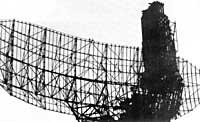History of the Naval Industry
Elhuyar Fundazioa

Before the invention of radioitelegraphy, silence prevailed in marine ships. From the port, through the open sea until reaching the finish line, the boat could not receive any help when anguish fell. The ship owners knew when the cruise began, but they didn't know when it was going to end. Maximum estimates would be made.
However, in the open sea there could be many things. It was often heard that the ship sank by storm or other motives and that people drowned. Navigation was in no way a danger. No wonder, therefore, that Guglielmo Marconi gave signs of Morse for the boats.
Marconi made his first essay at the Pontecchio in Reno in 1895. Along two kilometers between the transmitter and the receiver were transmitted without sincere morse cables.
Marconi's collaborators immediately realized the importance of the invention and the British Minister of Post. In Britain, they immediately offered all kinds of help to the Italian scientist.
Marconi adequately combined and applied the inventions and advances achieved previously by other scientists (Hertz, Onesti, Lodge, Tesla, Popoff, Braul, etc. ).
The first public sessions were held in Salisbury in 1896. The signals were emitted at a distance of four kilometers. Soon they managed to radio the chronicle of the Dublin races.
As a result of these first sessions, the company Marconi emerged with the aim of working the applications of the new invention. At the end of December 1898 a radio communication was made between two lighthouses. A lighthouse was on the ship "East Goodwin" anchored in the English Channel. The other, on land, at Cape South Foreland.
In a few months he issued distress signals for the five vessels in serious condition. A cargo saved with these signals was worth 53,500 pounds, ten times more than necessary for the radio supply to all lighthouse vessels in Britain, according to Marconi himself.

In 1899, the marine maneuvers in Britain took place for many days and nights using the radio. Radio communications were obtained between ships 74 miles. Two years later, Marconi first passed through the Atlantic Ocean the radio signal between St. Johns of Newfoundland and the Cornwall of Great Britain.
This test made everyone appear in favor of Marconi's invention and the company Cunard Line gave its "Lucania" radio stations and radio receivers. In short, all the company's ships were equipped with radio.
Thanks to the radio, since then many people have been saved in maritime accidents, as in 1909, when the transatlantic "Florida" and "République" were touched. The famous sinking of the "Titanic", however, cannot be silent. When in 1912 it hit the iceberg, the radio signals made the boats come to help.
Although the boats were not isolated by radio, they were missing to see them." When they circulated at night, when there was fog, when there were other boats nearby, when there were obstacles ahead or below, etc., it would be better to detect all of them. That "vision" he needed offered him the radar.
Although the essence of the radar is the XIX. In the 19th century, the electromagnetic waves expressed by the English Maxwell constituted the first French and American radars.
In North America they began to develop radar since 1922. In fact, boats passing through the Potomac River caused interference in radio signals. In France, for its part, in 1936 the installation of radar on the ship called "Normandie" was declared. Radar, large obstacles four miles away (ships, iceberg, etc.) could detect. Small obstacles a mile away.
In 1936 the radar was also installed in the port of Le Havre, extending to many warships and ports by 1939.
But when World War II broke out, no one was as well-equipped with radar as Britain. The mouth of the Thames River, for example, was protected from radar, like the entire coast. Each radar reached a distance of up to 150 kilometers and in the air up to 300 kilometers.

In the Battle of England, Goering planes and V-2 missiles were previously detected and the Italians also suffered great damage to the sea. The Germans also began to design the radar in 1937, but in 1940 the German navy had poor equipment and did not approach the British radars. In the triumph of the allies, therefore, he had to see the radar.
In 1940, Britain taught the United States the secret of radar. Therefore, it was also used in the war against the Japanese, and in late 1945 its use was officially announced.





